This week we're covering a rather traditional platforming affair with 16-bit flair. Tobe's Vertical Adventure was originally release on Xbox Live, but it has since been delisted in favor of the improved Windows version.
Friday, May 31, 2013
Wednesday, May 29, 2013
Nintendo Power Retrospectives - Part 14
Sunday, May 26, 2013
Dark Age of JRPGs (6): Seiken Densetsu 聖剣伝説 - PC-80 (1983)
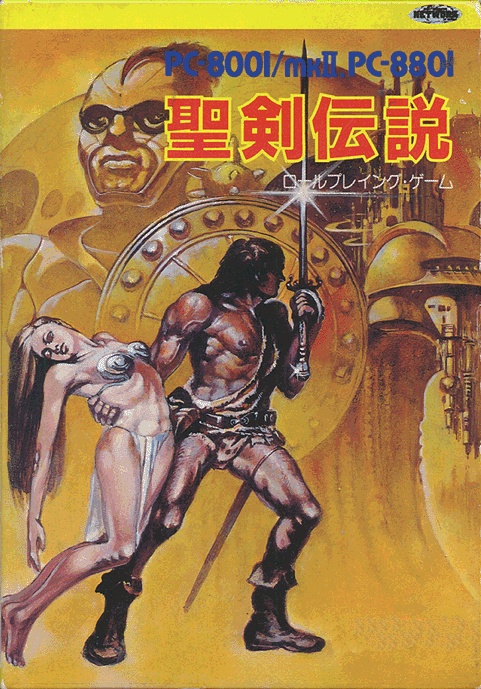
No, this has nothing to do with Square's popular Mana series, despite the identical Japanese title. This one was actually from Compaq - yes, they published a few games in the '80s - and like Dungeon very much inspired by the early Ultima games.
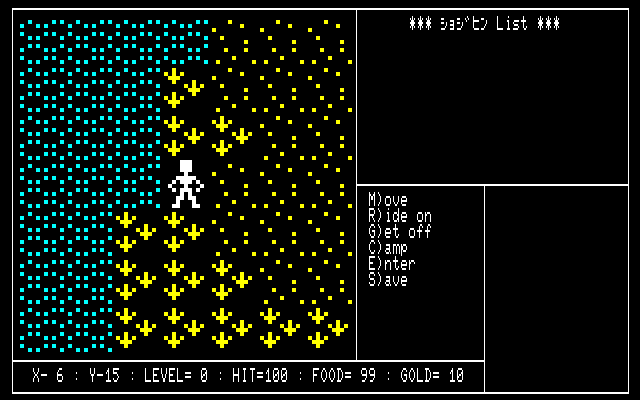
After creating your character (you can freely distribute a set amount of points between Strength, Agility, Charisma, Wisdom and Intelligence), you're dropped at this spot on an overworld map. Even getting around is a pain in the ass, though, because you have to press "M" before every single step. This is especially annoying on the laptop I'm using to play it, cause I have to switch the right part of the keyboard to turn into the numerical keypad, and "M" is inside that area, so I have to switch back and forth for every step.

Combat is weird as hell, but also somewhat interesting. Whenever you're confronted by a randomly appearing "army," you chose the number of rounds to be fought, before the opposing parties proceed to whack each other on the head. If you type "100," it's 100 rounds, if you type "1," it's just a single one, and so on. So if you fear you might lose the fight, typing a low number might be wise, but you're only getting loot if you take out the enemy entirely (which is typically 10 hits). The only problem? Even if enemies look exactly the same as others you've met before, their strength fluctuates wildly. Oddly, the game doesn't quit when you lose all your hit points, but you're stuck in the next fight, cause you cannot type in "0," but also no more than the amount of your hit points.
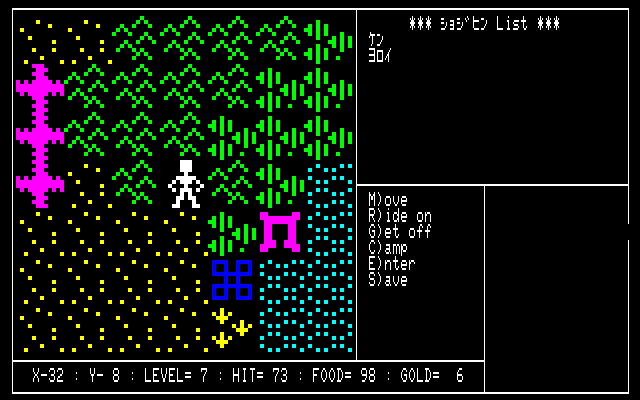
I don't know if this game has a dungeon, but it does have towns and castles, which fit on a single screen, like in the very first Ultima.
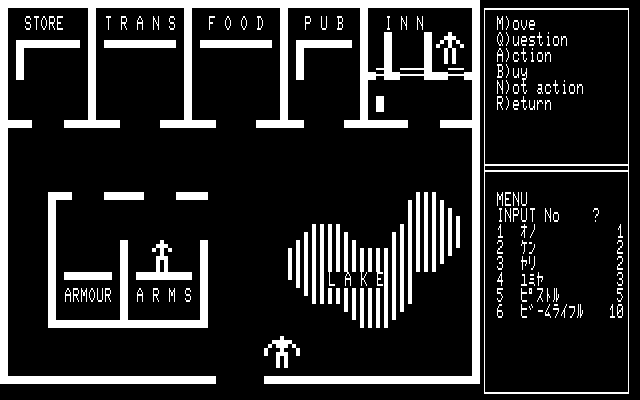
In the towns you can of course get equipped. It seems every weapons and armor you buy is equipped automatically, but I don't know if they accumulate... "Trans" is for transportation, and you can buy a bicycle, a horse, a boat, a coach, a car, a ship and a magic carpet. At the "Store" you get matches, water tanks, fishing gear and tents. The weirdest thing: Once you selected "buy" to see the wares, you can't seem to back out of the purchase again. As the other shop suggests, you consume food, but the game is rather generous with it. You start with 100 units, and it takes a long time before those are used up. I never managed to do anything at the pub.
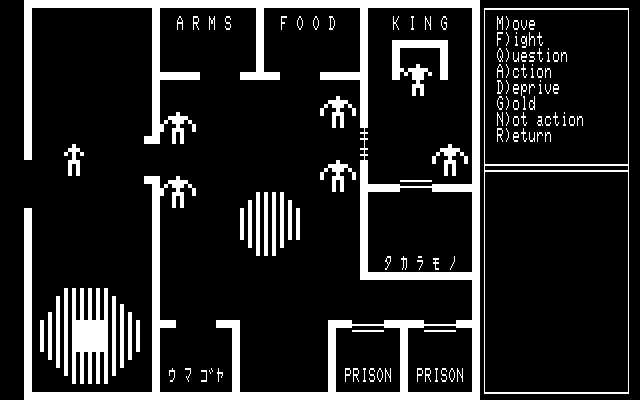
In the castle you can visit the king - if you know the password, which I don't. Moving on...
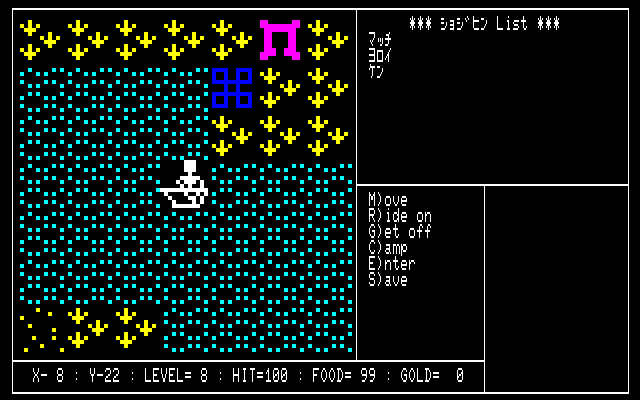
Crossing the river on my boat. The boat disappears after one use.
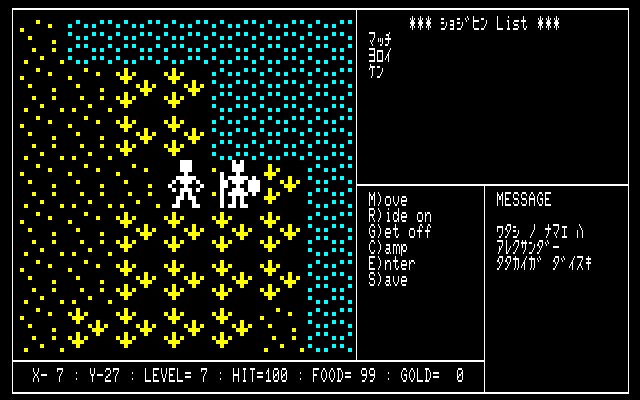
South of the river I've encountered these guys, but otherwise everything looks the same.
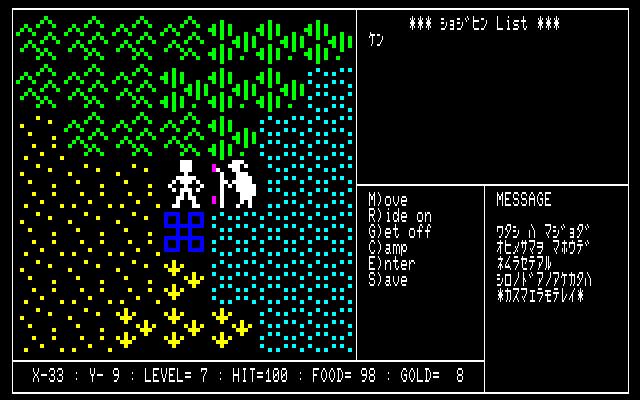
"I'm a witch. I've put the princess to sleep with my magic. The Way to open the white door is *Kasumaeramoterei*
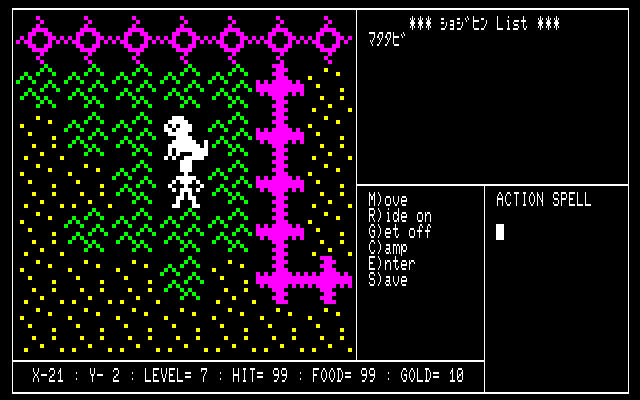
This guy requires an "action spell," which of course I don't know. It's white, but it doesn't look like a door...
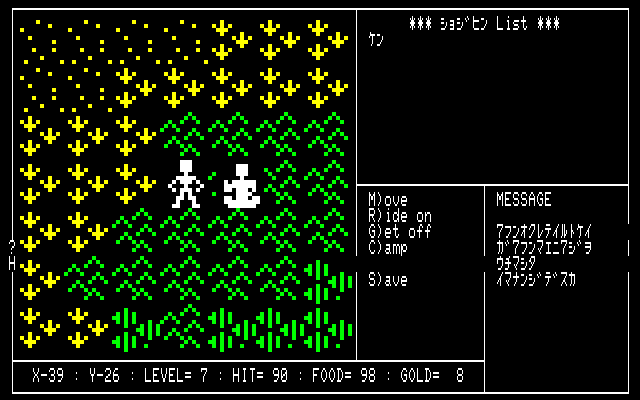
When wandering around the map, one eventually meets this guy, who appears again and again. He has some kind of riddle: "A clock that's 7 minutes late has shown 7 O'clock 7 minutes ago." But I couldn't type in the correct answer, cause the key of a necessary character (the "-like thing that turns consonants softer, like t into d or s into z) apparently isn't mapped on my keyboard.
Wednesday, May 22, 2013
500-Word Indies: Sturmwind
A bit early this week, cause I finally got back my Dreamcast and wanted to get this review out as soon as I could for anyone who's still on the fence about whether they really need yet another shmup for the system (short answer: yes). At least from the reviews I wrote, this was the hardest to keep close to 500 words so far. The game certainly should deserve a more thorough examination in a proper article some time further down the line, but for now there is at least this quick review.
The Nintendo Power Retrospectives - Part 13
Friday, May 17, 2013
500-Word Indies: Of Light & Shadow
Of Light & Shadow is a short but free puzzle platformer where you have to make use of the abilities of two quite polar opposite characters.
Wednesday, May 15, 2013
The Nintendo Power Retrospectives - Part 12
Tuesday, May 14, 2013
Interview with Digital Happiness, creators of DreadOut

Remember that cool Indonesian survival horror game we plugged a few days ago? We actually liked it so much we sent a bunch of questions to its developer, which was so kind to answer them for us.
They could still use some support for their Indiegogo campaign, which only runs for a few more days, so if you like survival horror and especially Fatal Frame, do consider backing it!
Monday, May 13, 2013
Dark Age of JRPGs (5): Dungeon ダンジョン - PC-80, PC-88, FM-7 (1983)
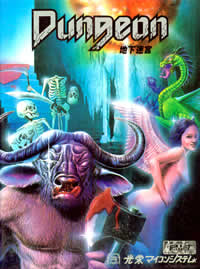
Koei's final RPG for 1983 follows the classic Ultima formula closer than any of the other games shown thus far. It's also one of the more accessible games of its period, as both the PC-80 and PC-88 versions are well-preserved. The title screen opens with a wizard who majicks open a door, from which then a swarm of bats comes flying out.
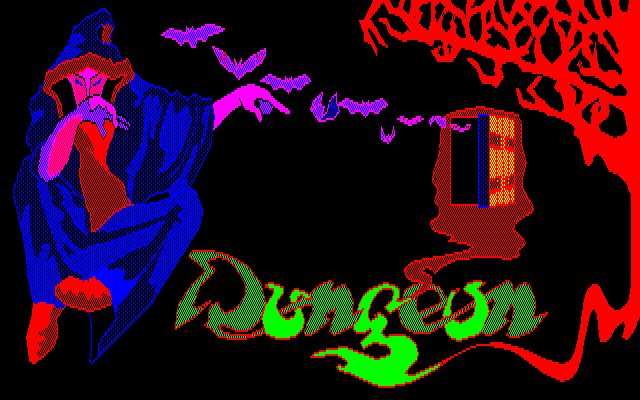
Character creation is simple: Chose between five classes - Soldier, Cleric, Magic User, Thief and Ninja (bit of a Wizardry influence there?) - then roll your stats. The flipping numbers for those stop by pressing escape, you can try as often as you'd like, and the process is really fast. After that you get five additional points to distribute at leisure, but with a decent roll, those don't really make much of a difference.
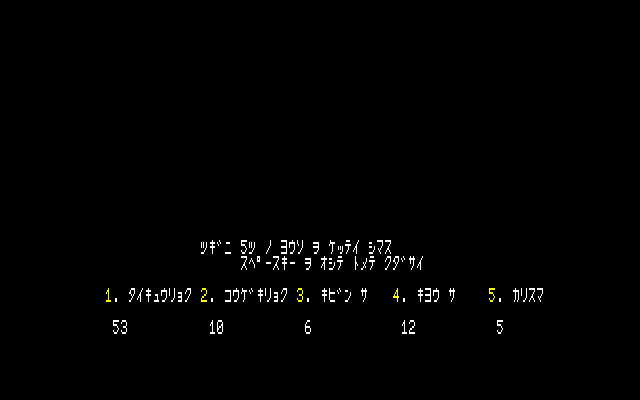
The stats are, from left to right: Stamina (HP), Attack Strength, Speed, Skillfulness and Charisma.
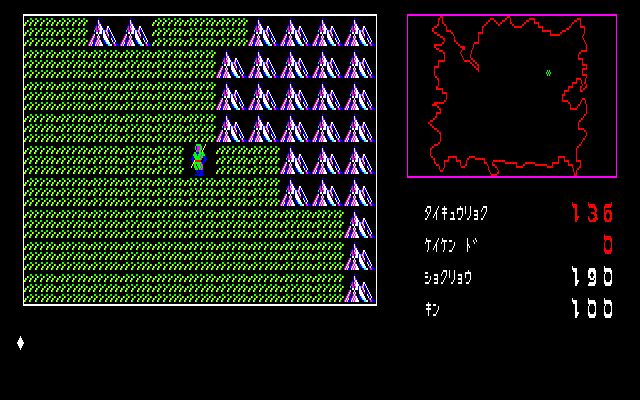
Each game starts at a random location on an island that constitutes the entire overworld. You can only hope to be spawned near a city - while it's possible to survive one enemy attack, another one is very likely fatal. The stats shown at the lower righthand side are stamina, experience, food (which is reduced with every step) and money.
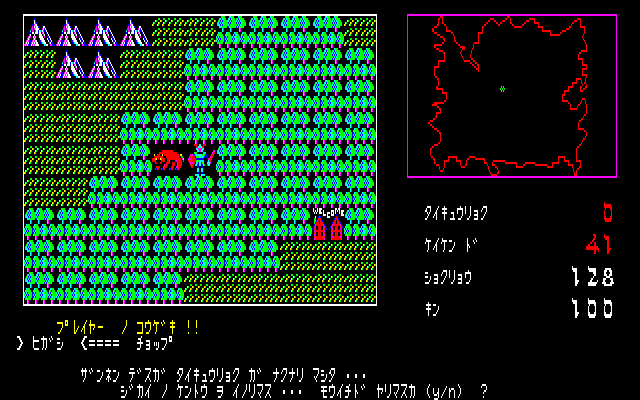
Like in Ultima, you enter a city or a dungeon by stepping on its field and pressing "E". The towns themselves are once again played in text adventure mode, like in Dragon & Princess. And even though the game is called Dungeon, I found the cities to be the true impenetrable labyrinths. I even found a guide in Japanese for the game, which explains that one can get healed and buy equipment by using (T)ransact at the right locations. But I can never seem to find the armory or the temple where this is supposed to happen. Whenever I try to (T)ransact with people, they just seem to take my money and do nothing else, or start to swear at me.
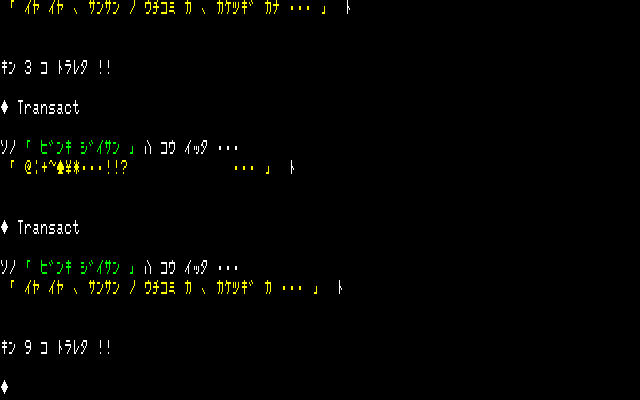
It seems the people actually have their daily schedules and walk around the city, and when no one's there, you can (S)teal stuff. If someone catches you, though, you get thrown in the titular dungeon. The catacombs are truly massive and seem to span the entire island underground. It has a few lower levels that are smaller, but the base level is ridiculously huge.
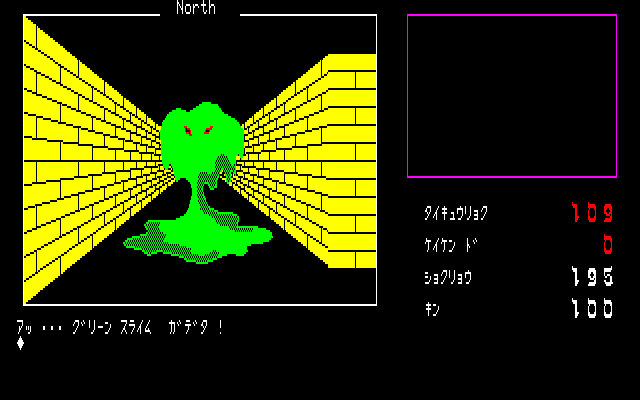
Enemies also walk around the dungeon in semi-real time, like in the first two Ultima games, before that series adopted Wizardry's party approach. Like in Ken to Mahou, there are several options for attack and defense, but their actual effects are just as dubious. Since I've never managed to buy any equipment or get myself healed, the same "2 enemies to die" rule from the field applies here as well, unfortunately. The monster designs are once again pretty cool as far as the typical D&D monsters go (That Japanese guide has images of them all, albeit in scaled-down form. Ours appear a bit downsized on the blog, but when you save them or open them in a new tab, they're actually in the original resolution):
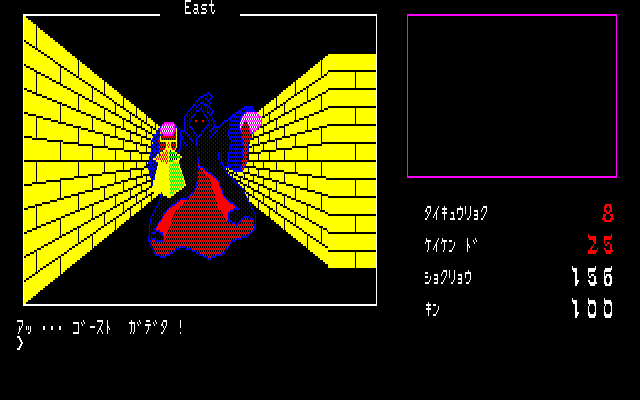
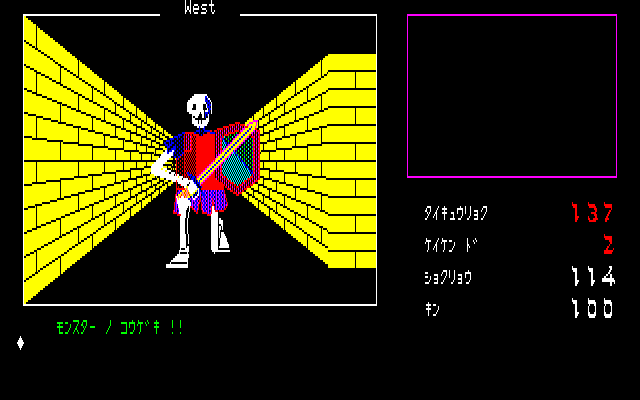
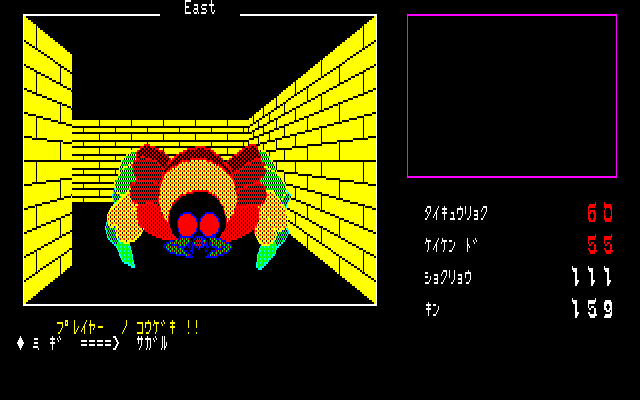
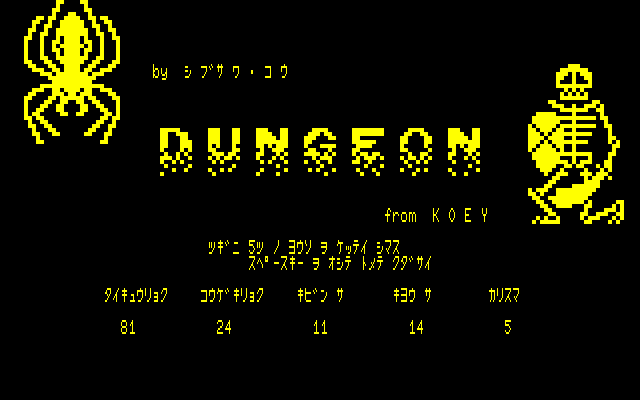
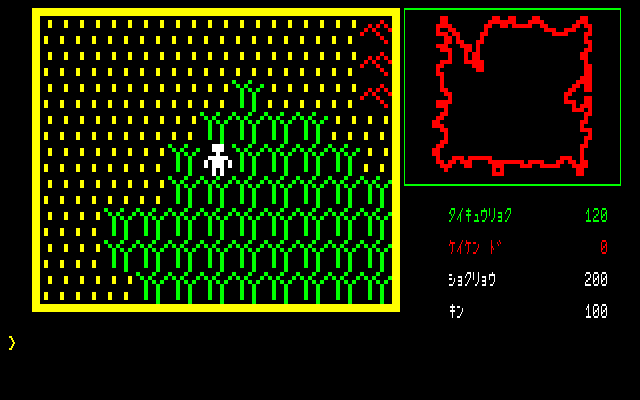
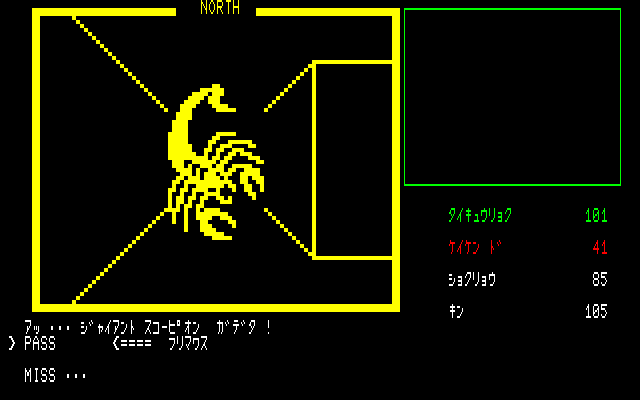
Friday, May 10, 2013
500-Word Indies: Dear Esther
For this week I decided to go outside my own comfort zone, and maybe that of most of HG101's core readership as well, by reviewing Dear Esther. It's not a particularly favourable review, but I avoided delving too much into "LOL it's not a real game" territory, although I think that's still a question with a justification to be asked, which I hope the final paragraph can make a decent case for.
Wednesday, May 8, 2013
The Nintendo Power Retrospectives - Part 11
Steve Wozniak interview, history of Apple
Monday, May 6, 2013
Dark Age of JRPGs (4): Ken to Mahou 剣と魔法 / Sword & Sorcery - PC-80, PC-88, FM-7 (1983)
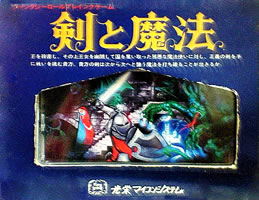
Last week I didn't get to do another entry unfortunately (although I technically didn't announce this as a weekly column anyway), and this one is rather brief as well, as we have another rather impenetrable game at hand. The Japanese title for Koei's next contribution to the genre is literally translated from the term "Sword & Sorcery," and that's what it also says on the title screen of some versions.
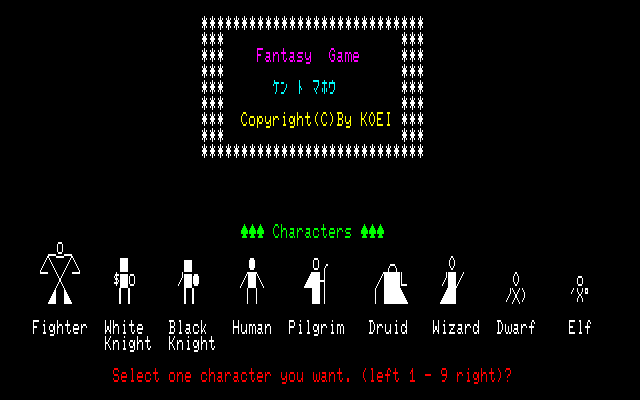
Once again the player controls only a single character, but this time one gets to chose from a range of predefined archetypes. Pictured is the PC-80 version, which builds its graphics entirely with the computer's text character set. The PC-88 and FM-7 versions have more or less defined sprite graphics. Below a screenshot of the PC-88 version from a Japanese site, notice how the Elf got changed into a "Fairly":

After chosing the character, the game shows a list of all the different enemies. In the character-only version, the most impressive are the "Demon C" (row 1 column 3), giant spider (row 2 column 2) and dragon (row 3 column 1). I also like how the torso of the princess that's supposedly to be rescued (lower right) is made up of a heart shape.
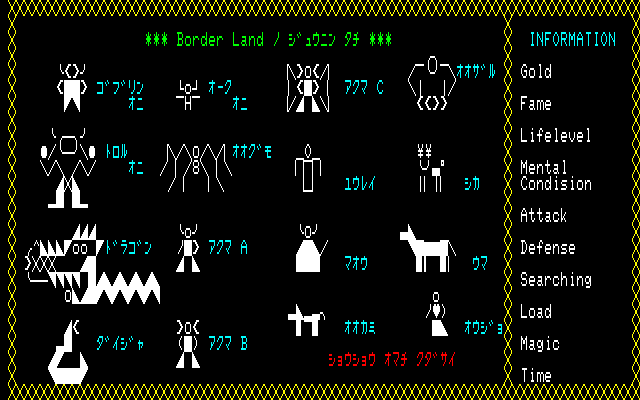
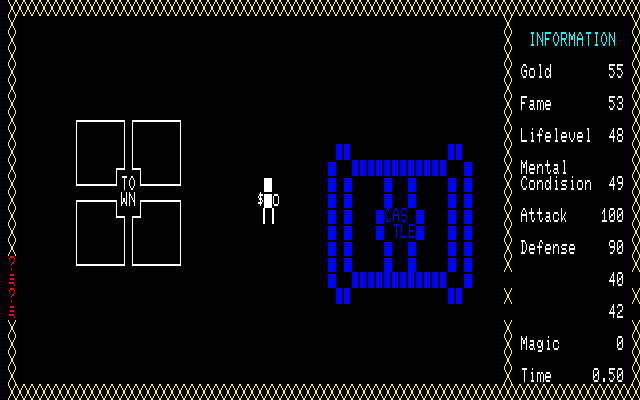
The game always starts out with the hero in between a town and a castle, although their colors and positioning slightly varies each time. It's hard to tell whether the complete world is randomized, or just the starting point within it.
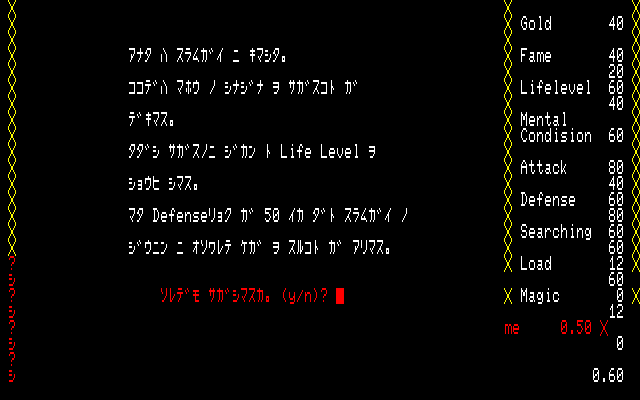
They wouldn't let me into the castle, but the town has the usual RPG mainstays that can be visited by typing numbers from a menu: a church, an inn, a smithy, a marketplace, private homes, a mansion and the slums. The slums are rather interesting: You can let your character search for magic items, but it consumes time and health. In the above screenshot you can also see how the status screen to the right gets all messed up when you make a false input.
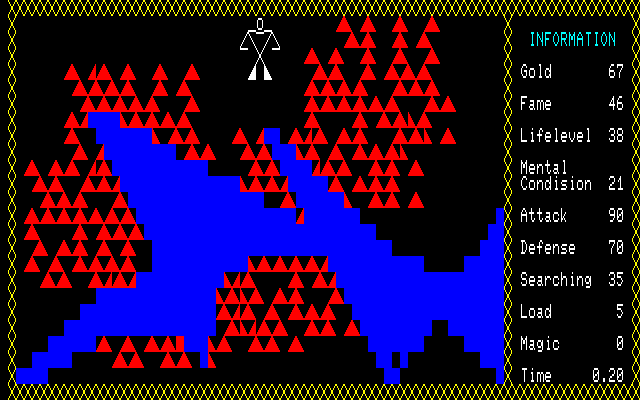
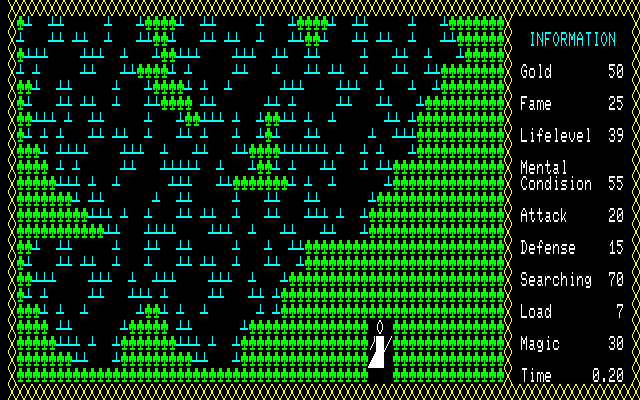
If you wander off from the first screen, you can only guess what kind of terrain the colored characters are supposed to represent. I figured the red triangles were mountains and the blue strucutre a lake, but I could still walk through them. I still never got very far though, because:
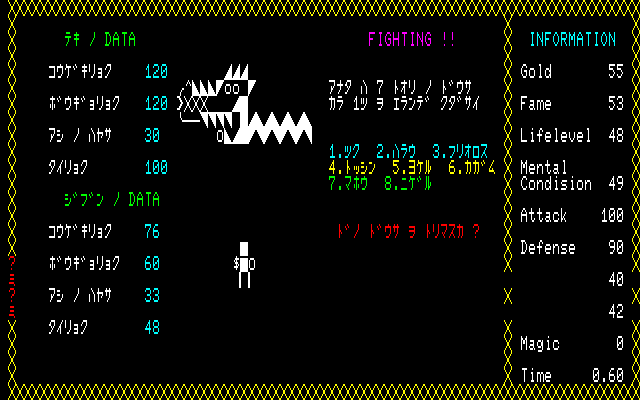
Every few seconds a random encounter is triggered, which brings us to this combat screen. This one is closer to Wizardry than Ultima, but since there's only one hero, the options to chose from have been expanded a bit. The first three are all different kinds of physical attacks, followed by the movements "charge," "avoid" and "stoop." The final two are "magic" and "escape." All this makes the combat sound more deep than it actually is, though: In each round simply both the hero and the monster lose some amount of health, and it goes on like this until one of them drops dead. For some reason the "attack" and "defense" values in Japanese to the left differ from the English ones to the right. I can usually win one or two battles (but not when it's a dragon) before succumbing to the ever attacking random monsters.
Some FM-7 version screenshots from Oh!FM-7:



Sunday, May 5, 2013
Update 5/5 - Hang On, AB Corp, Buck Rogers: Planet of Zoom / Zoom 909, Comix Zone, Holosseum, Double Switch, Satan's Hollow

We've been covering a lot of Sega games recently, mostly to prepare for the upcoming Sega Arcade Classics Volume 2 (release date: totally unknown, because I have to finish the Castlevania book one first). First up is Hang-On, Yu Suzuki's motorcycle racing game, which spawned a handful of spinoffs that are basically part of the same series despite having different names. (I heavily suggest checking out the sadly overlooked/unported Racing Hero as a good follow-up to the series.) As an accompaniment piece, we're also featured AB Cop, a more futuristic, combat-oriented take on the sprite-based 3D motorcycle racing formula. And Buck Rogers: Planet of Zoom (AKA Zoom 909 is essentially the first in Sega's super scaler series, with remarkable sprite graphics that demolish practically every other arcade game out in 1982, even though from a gameplay perspective, it's easy to see why a better game like Space Harrier is far more widely recognized.
We're also finishing up coverage of some more beat-em-ups and fighting games. Comix Zone was developed for the Genesis by the US-based Sega Technical Institute, where an artist is sucked inside his comic book and has to pummel his creations. It's an incredibly creative game, though short, and incredibly difficult. There's also Holosseum, a rather awful fighting game that exists solely for Sega to do something with the hologram arcade cabinets the company had developed for the FMV game Time Traveler. The whole thing loses its purpose when played on MAME, but the game's kinda bad anyway.
Onto other things: Double Switch is essentially the follow-up to Night Trap, the infamous FMV vampire-trapping/voyeur game. The cast of characters and story is totally different, starring Corey Haim and the lead singer from 80 band Blondie, but the gameplay is practically identical. And Satan's Hollow is Bally/Midway's attempt at a Space Invaders clone, though with a more demonic theme. The two 500-Word Indies features include The Adventures of Shuggy, an unfortunately overlooked puzzle platformer from the same guys that brought you Gateways, and A Tale of Two Kingdoms, a rather stunning looking adventure game that works as an ode to Kings Quest.
Finally, the Hardcore Gaming 101 Presents: Sega Arcade Classics Vol. 1 book is on sale at Amazon for less than $18. I don't set when/where these sales happen, and I don't see the price dipping much further, so if you've been waiting to pick it up, now's the best time to do it before the price goes back up! B&W edition is also on sale for $9, which is a dollar off the normal price.
Friday, May 3, 2013
500-Word Indies: The Adventures of Shuggy

So far this series has been mostly PC-centric, but this week it's getting the first Xbox Live Arcade title (although a Windows version is available as well): The neat platformer The Adventures of Shuggy, done by the same team as Gateways, which we've covered in detail before.
I would have done an overnight review of Sturmwind, since Redspot Games finally managed to deliver it about two years after I placed my preorder... but I don't have my Dreamcast available at the time being, the disc refuses to let itself get dumped, and the Dreamcast emulators all don't seem to take games on actual CD-ROMs (ignoring the question whether they can even run the game). So I guess it's still more waiting for me... what a bummer!
Thursday, May 2, 2013
Two interesting horror games you can help funding right now
At Hardcore Gaming 101, we're all for promoting cultural diversity in video gaming, and right now there are two opportunities for everyone to help making our gaming world more interesting through the funding of game development from outside the typical regions:
Dreadout is survival horror very much in the style of Tecmo's Fatal Frame series (which the developers openly compare their game to), but transferred into a more contemporary setting where the heroine uses her smartphone camera to deal with the ghosts on an high school trip that went awry. Developed by Digital Happiness in Indonesia, the game also channels Southeast Asian horror flick aesthetics. There's a demo available for download, which is already incredibly creepy.
The funding campaign runs on the niche platform Indiegogo, which explains why the project appears to have a hard time to even reach its basic goal. The way it is set up, Digital Happiness will get the support even if the goal is missed, but Indiegogo's share would be much bigger that way.
Among the Sleep by the Norwegian Krillbite Studio doesn't have that problem as it's on Kickstarter. It started out as a thesis project of a bunch of digital arts students, and is now being polished into a full game. The game seeks to explore the experiences in the nigtmares of a toddler, who still hasn't fully developed a sense of reality, which should hopefully make for some thoroughly surreal events and environments. Getting access to the early alpha build seems to require a rather high tier contribution, but Jim Sterling has recorded a run trough it at The Escapist.






